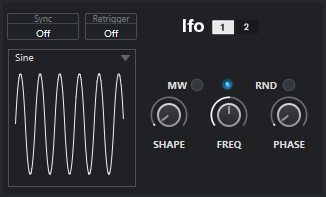LFO Editor
Sampler Control provides two monophonic LFOs. These LFOs are only calculated once and feed all voices at the same time.

- LFO
-
Allows you to select LFO 1 or 2 for editing.
- Sync
-
Defines how the speed of the corresponding LFO is set.
-
Off allows you to set the LFO speed in Hz.
-
Tempo + Retrig allows you to set the LFO speed in note values. The resulting rate depends on the tempo of your project.
-
Tempo + Beat allows you to set the LFO speed in note values. The resulting rate depends on the tempo of your project. Additionally, the current start phase is calculated based on the current position.
-
- Retrigger
-
Defines whether the LFO is restarted with the specified start phase when a new note is triggered. This parameter is available for the sync modes Off and Tempo + Retrig.
-
If Off is selected, the LFO is not restarted.
-
First Note restarts the LFO when a note is triggered and no other note is held.
-
Each Note restarts the LFO every time that a note is triggered.
-
- MW
-
Allows you to scale the output level of the LFO via the modulation wheel of your keyboard. This allows you, for example, to control the vibrato of the sound with the modulation wheel.
- Waveform
-
Sets the waveform for the selected LFO. You can adjust the selected waveform using the Shape control to the right.
-
Sine produces smooth modulation, suitable for vibrato or tremolo. Shape adds additional harmonics to the waveform.
-
Triangle is similar to Sine. Shape continuously changes the triangle waveform to a trapezoid.
-
Saw produces a ramp cycle. Shape continuously changes the waveform from ramp down to triangle to ramp up.
-
Pulse produces stepped modulation, where the modulation switches abruptly between two values. Shape continuously changes the ratio between the high and the low state of the waveform. If Shape is set to 50 %, an even square wave is produced.
-
Ramp is similar to the Saw waveform. Shape increasingly adds silence before the sawtooth ramp up begins.
-
Log produces a logarithmic modulation. Shape continuously changes the logarithmic curvature from negative to positive.
-
S & H 1 produces randomly stepped modulation, where each step is different. When fully turned right, Shape puts ramps between the steps and changes the sample and hold signal into a smooth random signal.
-
S & H 2 is similar to S & H 1. The steps alternate between random high and low values. When fully turned right, Shape puts ramps between the steps and changes the sample and hold signal into a smooth random signal.
-
- Freq
-
Controls the frequency of the modulation, that is, the speed of the LFO.
If Sync is activated for the corresponding LFO, the speed is specified in fractions of beats. If Sync is deactivated, you can set the frequency in Hz.
- Phase
-
Sets the initial phase of the waveform when the LFO is retriggered. If RND is activated, each note starts with a randomized start phase.